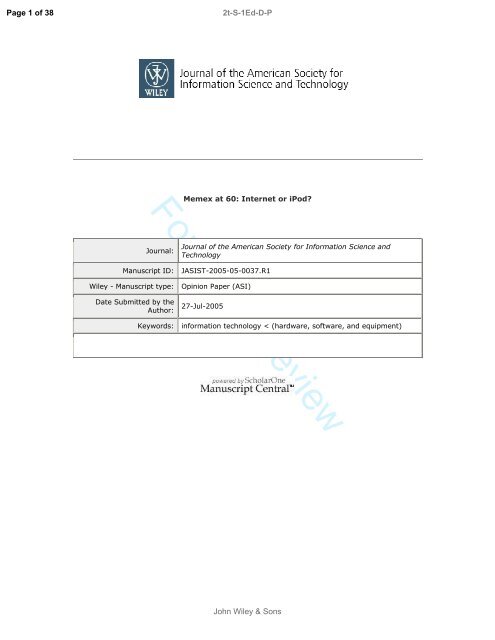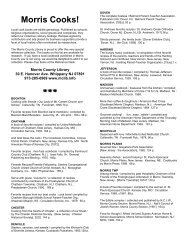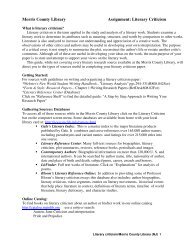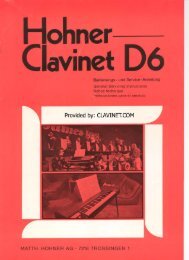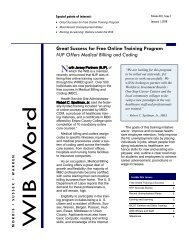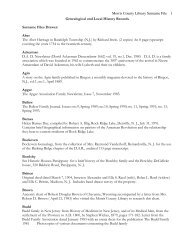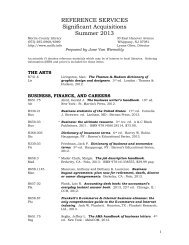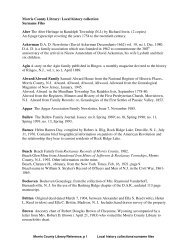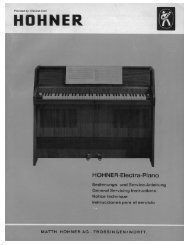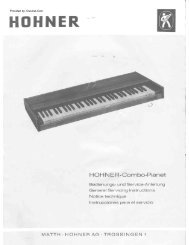Create successful ePaper yourself
Turn your PDF publications into a flip-book with our unique Google optimized e-Paper software.
Page 1 of 38<br />
<strong>For</strong> <strong>Peer</strong> <strong>Review</strong><br />
Journal:<br />
Memex at 60: <strong>Internet</strong> or iPod?<br />
Journal of the American Society for Information Science and<br />
Technology<br />
Manuscript ID: JASIST-2005-05-0037.R1<br />
Wiley - Manuscript type: Opinion Paper (ASI)<br />
Date Submitted by the<br />
Author: 27-Jul-2005<br />
2t-S-1Ed-D-P<br />
Keywords: information technology < (hardware, software, and equipment)<br />
John Wiley & Sons
Richard H. Veith<br />
Memex at 60: <strong>Internet</strong> or iPod?<br />
R. Veith Consulting, 435 Hoffman Road, Port Murray, NJ 07865. E-mail:<br />
rveith@gti.net<br />
Abstract<br />
2t-S-1Ed-D-P<br />
<strong>For</strong> <strong>Peer</strong> <strong>Review</strong><br />
It has been sixty years since the 1945 Memex article, and so much has changed<br />
since then that we might well wonder whether the article is still worth looking at. It<br />
certainly inspired some of the leading figures in information technology, but now it<br />
seems to be cited either for things it did not really say, or because everything it proposed<br />
has been pretty much accomplished, albeit with alternate technology. If we take another<br />
look at the Memex description, though, there are a few key ideas that can still be goals in<br />
terms of an easy-to-use personal collection that is a supplement to one’s own memory.<br />
Perhaps in today’s terms, the device would be a combination of the iPod design and a<br />
tablet computer. As such, it could function as a handy information pod, with certain<br />
Memex features, serving as an extended personal memory.<br />
1<br />
John Wiley & Sons<br />
Page 2 of 38
Page 3 of 38<br />
Introduction<br />
Thomas Watson, Sr., chairman of IBM, is quoted as saying in 1943, “I think there<br />
is a world market for maybe five computers.” Vannevar Bush said something similar in<br />
his 1945 “As We May Think” article: “With machines for advanced analysis … there was<br />
and is no extensive market.” But nobody pays much attention to that. Instead the article<br />
<strong>For</strong> <strong>Peer</strong> <strong>Review</strong><br />
is remembered and cited for other reasons, and even (many times it seems) for ideas it did<br />
not espouse at all.<br />
My purpose here is to take another look at what the 1945 article really said about<br />
the Memex, as opposed to extrapolations and extensions that have accumulated over the<br />
years, to see if the Memex article has anything to say to us today. The grand thing about<br />
the 1945 Memex description is that technology has so surpassed the dated description of<br />
levers and relays and microfilm that we all feel free to pick the parts to take literally, the<br />
parts to treat liberally, and the parts to ignore.<br />
Background<br />
2t-S-1Ed-D-P<br />
Before addressing the 1945 article directly, it may be helpful to summarize the<br />
historical setting for the article in three respects: its publication history; the related (but<br />
different) machine called the Rapid Selector; and the broader context of the Memex<br />
concepts. Because there seems to be much misconception about the 1945 article, this<br />
2<br />
John Wiley & Sons
summary is intended to establish a basis for discussion even though some of it may be<br />
familiar to those who know the article and its history well.<br />
Drafts and Delays<br />
2t-S-1Ed-D-P<br />
There are a number of texts that explain the origin and eventual publication of the<br />
<strong>For</strong> <strong>Peer</strong> <strong>Review</strong><br />
Memex article, principally the compilation by Nyce and Kahn (1991b), and sections of<br />
the Zachary (1997) biography. As Nyce and Kahn point out, the article was really based<br />
on ideas and technology from the early 1930s, and Bush later estimated that he first<br />
formulated the Memex ideas around 1932. In 1937 he sought funding from the<br />
Rockefeller Foundation to build a Memex-like machine although it was not called that<br />
and it differed in some respects from the later Memex description (Nyce & Kahn, 1991a).<br />
By the end of 1939, Bush had a draft of an article called “Mechanization and the Record”<br />
which he sent to the publisher of <strong>For</strong>tune magazine to get the publisher’s reaction. This<br />
draft used the name “Memex” for the first time and in fact contained all the material in<br />
the 1945 article except for the opening and concluding sections. <strong>For</strong> a number of<br />
reasons, particularly the pressure of national defense matters, Bush set the article aside<br />
and did little or nothing with it until 1944, submitting the draft this time (with a new<br />
opening section reflecting the coming end of the war) to the Atlantic Monthly. The<br />
Atlantic Monthly editor, in addition to publishing the article, decided to add an editor’s<br />
introduction to highlight the importance of the article.<br />
3<br />
John Wiley & Sons<br />
Page 4 of 38
Page 5 of 38<br />
The interest in the article was such that Life Magazine requested and received<br />
permission to print a condensed, illustrated version of the article in the September 1945<br />
issue. The editors of the Life article, under the heading “What Dr. Bush <strong>For</strong>esees,”<br />
highlighted five significant things: (1) the mini-camera and dry photography; (2)<br />
miniaturized microfilm; (3) speech to text (i.e., a machine that would type when spoken<br />
to); (4) advanced mathematical calculators that could generate conclusions from premises<br />
<strong>For</strong> <strong>Peer</strong> <strong>Review</strong><br />
(called “thinking machines”); and (5) the Memex, a machine that files items by<br />
association, and can run through trails of associations at the touch of a button (Bush,<br />
1945b).<br />
2t-S-1Ed-D-P<br />
During the several decades following that, Bush began to adjust and modify his<br />
Memex concept in light of newer technology and perhaps in response to critical<br />
comments about one aspect or another. By the end of 1958, he was writing drafts of a<br />
manuscript called “Memex II” (Kahn & Nyce, 1991). <strong>For</strong> a year or two, Bush tried to<br />
get it published in Atlantic Monthly and Life. The Atlantic Monthly was willing to<br />
publish it, but wanted Bush to “polish it, which it badly needs.” Instead, Bush dropped<br />
the idea of getting it published at that time. In 1965, he was apparently looking again at<br />
the Memex idea, and working on an essay that became “Memex Revisited,” published in<br />
1967 in the final collection of Bush’s essays, Science Is Not Enough.<br />
Despite the fact that Vannevar Bush modified his Memex concepts somewhat as<br />
time passed, it is the 1945 Atlantic Monthly article that is still cited as the basis for<br />
almost all of the subsequent claims concerning the Memex.<br />
4<br />
John Wiley & Sons
The MIT Rapid Selector<br />
The Rapid Selector was a mechanical device for selecting microfilm frames,<br />
designed by Vannevar Bush, built at MIT beginning in 1938 and developed over a period<br />
of several years. The basic idea of the MIT Rapid Selector was that document abstracts<br />
<strong>For</strong> <strong>Peer</strong> <strong>Review</strong><br />
would be contained on reels of 35 mm microfilm such that one half of each frame was the<br />
16 mm image of an abstract, and the other half provided space for codes (represented as<br />
optical dots). When searching for frames matching a given set of codes, a card would be<br />
created (though later the card was replaced by a drum device) with the desired dot<br />
pattern, and the reeled microfilm would spin past the card. Photocell detectors would<br />
determine when a code pattern in the microfilm matched the pattern on the card, and that<br />
document image (the abstract) would be optically copied to 16 mm film. All of this was<br />
to happen so fast that 60,000 frames could be searched in a minute. In practice, though,<br />
the machine that was built had to be slowed down considerably due to mechanical and<br />
electronic problems, it was not too reliable in operation, and the effort associated with<br />
preparing and coding the abstracts appeared to be operationally and financially<br />
prohibitive (Burke, 1991). This selector, or more specifically a version of it, was really<br />
only used for a short period during the war “as something of a pattern locator” for<br />
analyzing codes in Japanese messages.<br />
2t-S-1Ed-D-P<br />
5<br />
John Wiley & Sons<br />
Page 6 of 38
Page 7 of 38<br />
Some commentators have suggested that the MIT Rapid Selector is a good<br />
example of how the Memex might have been built, but there are several major<br />
differences between that selector and the Memex described in the 1945 article.<br />
The first major difference is the method of selection. Because the Memex<br />
concept required extremely fast access to hundreds of millions of microfilmed images,<br />
<strong>For</strong> <strong>Peer</strong> <strong>Review</strong><br />
Bush discounted the sequential scanning method of the MIT Rapid Selector, and instead<br />
proposed a system more like a telephone exchange, where each digit rapidly narrows the<br />
selection range. Thus, if you know the number of the item you are seeking, the machine<br />
would arrive at the selected document as soon as the final digit was processed. Bush<br />
pointed out that the mechanical relays of the telephone-exchange method could be<br />
replaced by vacuum tube switches, enabling selections within a hundredth of a second. It<br />
is worth noting that this same idea has subsequently been used in digital storage systems,<br />
where the ID number of an item is directly related to the physical path to the data on disk.<br />
<strong>For</strong> example, the British Prestel system was developed in the mid-1970s using such a<br />
scheme in order to rapidly handle potentially thousands of simultaneous online requests<br />
for Prestel pages.<br />
2t-S-1Ed-D-P<br />
The second major difference is the method of associating one frame with another.<br />
In the MIT Rapid Selector, frames related to each other (i.e., in the same category) would<br />
have the same code or set of codes. But in the Memex, the dots in a microfilm frame<br />
would actually be the index number of the next related frame. Thus, one microfilm frame<br />
is linked to another with the link embedded in that frame, so that when viewing any given<br />
6<br />
John Wiley & Sons
frame, the information is there for the machine to rapidly select the next linked frame in a<br />
given trail.<br />
More generally, the MIT Rapid Selector and the Memex had different intended<br />
users, and the timeframes for development were different. The Rapid Selector was<br />
intended for organizational use where the organization would expend the effort to create<br />
the abstracts, classify them, and add the classification codes. Further, it was designed to<br />
<strong>For</strong> <strong>Peer</strong> <strong>Review</strong><br />
be built with available technology. The Memex, on the other hand, was intended for<br />
personal use (more about this later), and was proposed with near-future technology in<br />
mind, i.e., using primarily known methods and elements, extending those in terms of<br />
smaller size and faster speed, and assuming near-term resolution of the technical<br />
difficulties not yet solved.<br />
The Broader Picture<br />
2t-S-1Ed-D-P<br />
The 1945 article pulled together a lot of ideas, and it is not a criticism of the<br />
article to acknowledge that many of the ideas had also been voiced by others. Robert<br />
Fairthorne is quoted as saying that “few of his [Bush’s] suggestions were original” in<br />
Buckland’s (1992) review of relevant technological developments that predated both the<br />
MIT Rapid Selector and the Memex article. Vannevar Bush was not the first to comment<br />
on the accumulating volume of recorded information nor the first to look for machine-<br />
based solutions. The following quick summary of the Memex article’s relationship to<br />
prior developments addresses three aspects: microfilm for storing masses of documents;<br />
7<br />
John Wiley & Sons<br />
Page 8 of 38
Page 9 of 38<br />
techniques for extremely fast selection of desired frames; and techniques for associating<br />
ideas.<br />
2t-S-1Ed-D-P<br />
With regard to microfilm itself, the Memex concept was on solid ground. In the<br />
1920s and 1930s, microfilm was a popular storage technology, and a grainless microfilm<br />
able to contain the entire Bible fifty times within a square inch had been demonstrated in<br />
<strong>For</strong> <strong>Peer</strong> <strong>Review</strong><br />
1925. A workstation containing hundreds of thousands of microfilmed document pages<br />
had been developed in the 1930s by Sebille (Buckland, 1992). A microfilm selector<br />
using photoelectric cells had been developed in Germany by Emanuel Goldberg at Zeiss<br />
Ikon, and the machine was patented in both Germany and the United States around 1931<br />
or 1932. And in late 1932, the same year that Vannevar Bush says he first began putting<br />
together the idea of a Memex, Bush was visited by Watson Davis. Davis was well<br />
acquainted with developments in both the U.S. and Europe regarding the use of<br />
microfilm for storing and viewing document collections, and pitched his own ideas for<br />
microfilm to Bush, possibly planting the seed in Bush’s mind (Zachary, 1997, pp. 74-75).<br />
At the time Bush was working on his Rapid Selector, in the United States<br />
companies like NCR and Eastman Kodak were also working on microfilm retrieval<br />
machines. In fact, both were financial sponsors of the MIT Rapid Selector, and Kodak<br />
even shared information about its own work with Bush (Burke, 1991). Bush and his team<br />
made several attempts to patent their own rapid selector, but the patent claims were<br />
denied due to a list of prior patents that “continued to grow” (Burke, 1991).<br />
8<br />
John Wiley & Sons
Regarding the techniques for selecting desired frames, the Memex description<br />
does depart from earlier microfilm selectors. Most of the schemes suggested involved<br />
attaching a code, or set of codes, directly to a microfilm frame, and then employing a<br />
sequential search through all the frames to find the matching codes. This was the method<br />
used in the MIT Rapid Selector. But, as mentioned above, it was not the method<br />
suggested by the Memex article. Instead, a system similar to telephone switching<br />
<strong>For</strong> <strong>Peer</strong> <strong>Review</strong><br />
exchanges would be employed, with the switching done using vacuum tubes for high-<br />
speed selection.<br />
Actually, there are two aspects of this selection technique that are worth<br />
reviewing. First is the telephone exchange model. Bush seems to have been aware of<br />
ongoing developments at Bell Telephone Laboratories, so he may or may not have been<br />
familiar with specific attempts to use telephone switch technology for other purposes.<br />
<strong>For</strong> example, beginning in 1937 George Stibitz was using telephone relays to create first<br />
a simple adder and later a complex number calculator, called the Relay Calculator. The<br />
telephone switch idea, as a selection mechanism, implies that the microforms within a<br />
Memex may need to be stored in a physical arrangement corresponding to each item’s ID<br />
number (perhaps an accession number). <strong>For</strong> example, when the final number in the ID<br />
has been processed by the last switch, the machine should be pointing at the physical<br />
location of the microform frame, just as in a telephone switch it finally arrives at the<br />
location of the dialed line.<br />
2t-S-1Ed-D-P<br />
9<br />
John Wiley & Sons<br />
Page 10 of 38
Page 11 of 38<br />
The second aspect of the selection technique described in the Memex article is<br />
that any given item contains the actual ID number of the next desired item. In other<br />
words, when a topic trail is being followed, one item will contain in the microfilm a dot<br />
pattern representing the “index number of the other item” (Bush, 1945a). Given that item<br />
A can point to item B, and B can point to C, as well as C pointing to B and B to A, and so<br />
on through a series of items, this is a good example of a doubly linked list. In fact, this<br />
<strong>For</strong> <strong>Peer</strong> <strong>Review</strong><br />
might be one of the first articles, if not the first article, in computing literature to describe<br />
a doubly linked list, since linked lists are often attributed to developments in the 1950s.<br />
In any event, the linked list idea meant that selection is still by ID number only, rather<br />
than sequentially scanning for all items with a given topic code. In the Memex article,<br />
any item could belong to more than one linked list, and the maximum number of lists that<br />
any one item could belong to would be limited by the available space on the microfilm<br />
frame for dot patterns.<br />
2t-S-1Ed-D-P<br />
Finally, there is the matter of the association of ideas. Vannevar Bush wanted to<br />
break away from hierarchical classifications and he wanted to provide a mechanized way<br />
to support multiple associations among items. His argument was that the mind works by<br />
association, that one item suggests another because of a “web of trails” in the brain. With<br />
the Memex, he was not getting too carried away though; he simply wanted a mechanized<br />
way for a person to link any two items together based upon that person’s own reasons for<br />
the association. The Memex article was not concerned with long-standing philosophical<br />
views of how ideas in the mind are associated, but rather with the subset of logical<br />
associations that a researcher might make. <strong>For</strong> example, items would be associated using<br />
10<br />
John Wiley & Sons
the same principles as when gathering items “together to form a new book” (to use a<br />
phrase from the article slightly out of context). It was this restricted notion of association<br />
that Bush sought to mechanize.<br />
2t-S-1Ed-D-P<br />
As Rayward (1994, 1997) has pointed out, others were at work in the early 1900s<br />
to find mechanical means for associating ideas, and in particular Paul Otlet and the<br />
<strong>For</strong> <strong>Peer</strong> <strong>Review</strong><br />
International Institute of Bibliography beginning around 1895. (We might speculate that<br />
Vannevar Bush heard about Otlet’s work indirectly, via the visit from Watson Davis in<br />
1932, but there is no solid evidence one way or the other.) Essentially, Otlet’s scheme<br />
was to copy individual ideas or “chunks” of information from articles and books onto<br />
standardized cards, which allowed “all the manipulations of classification and<br />
continuous interfiling.” The cards were filed within a classification system (Universal<br />
Decimal Classification) such that associated ideas would be filed under the same<br />
classification number, perhaps in separate cabinets but still under the same classification.<br />
This allowed researchers to find related concepts that may have been expressed anywhere<br />
within any of the pamphlets, articles or books covered by the system. By 1930, one such<br />
collection of cards had nearly 16 million items.<br />
Otlet also worked with microfilm, and was impressed by the potential of radio,<br />
television and records in achieving the same information and communication goals as<br />
books. In Otlet’s 1934 Traité de Documentation, he envisions someday books being<br />
replaced by the newer technologies. He also envisioned a researcher’s desk with multiple<br />
desktops, electrically controlled filing cabinets such that a desired cabinet would slide<br />
11<br />
John Wiley & Sons<br />
Page 12 of 38
Page 13 of 38<br />
quickly (on rails) into place at deskside, and even television screens for remote viewing<br />
of items. In fact, Otlet believed that eventually the researcher’s desk would be just a<br />
telephone and viewing station, with all the actual materials housed in massive collections<br />
elsewhere.<br />
2t-S-1Ed-D-P<br />
A major difference between Otlet’s suggestions and the Memex is that Vannevar<br />
<strong>For</strong> <strong>Peer</strong> <strong>Review</strong><br />
Bush pretty much ignored the use of any classification scheme to govern the association<br />
of ideas. <strong>For</strong> the individual researcher this may be reasonable, and the researcher could<br />
implement his or her own schemes if desired. But for all the material that a Memex<br />
might acquire with pre-established linked lists, there is no statement in the Memex article<br />
indicating what would govern the logic of the connections. It is as if Bush, as a<br />
scientist/engineer, was principally interested in the mechanics of the device, and would<br />
let others decide how to exploit the capabilities of the machine.<br />
Regardless of the degree of originality, there is no doubt at all that the 1945 article<br />
was popular in its own time, due in part to Bush’s academic and political prominence. It<br />
is also clear that the article provided inspiration to later influential system designers.<br />
Douglas Engelbart (reprinted in Nyce & Kahn, 1991a) has said “ … the article influenced<br />
me quite basically.” Ted Nelson (reprinted in Nyce & Kahn, 1991a) considers himself a<br />
“counter-disciple” of Bush, believing that the article “runs counter to virtually all work<br />
being pursued under the name of information retrieval today [in 1972]” but that “Bush<br />
was right.” J. C. R. Licklider dedicated his 1965 book, Libraries of the Future, to Dr.<br />
12<br />
John Wiley & Sons
Bush, saying that while he had not read the article until recently, he had “often heard<br />
about Memex and its ‘trails of reference’” (Kahn & Nyce, 1991).<br />
Basic Concepts<br />
<strong>For</strong> <strong>Peer</strong> <strong>Review</strong><br />
The following section examines the 1945 Atlantic Monthly article itself for what<br />
it said and what it did not say, as a basis for distilling what I believe are the essential<br />
elements and comparing that to what we have today.<br />
Article Components<br />
The 1945 article, taken as a whole, makes a lot of suggestions about future<br />
technology not necessarily related to the Memex. The Atlantic Monthly article did not<br />
contain any subheadings, only numbered sections, and it is not particularly easy to see the<br />
overall structure. However, the article can basically be divided into two parts (aside from<br />
the introduction and conclusion) that discuss the creation of data collections and the<br />
selection of items from those collections. (See Table 1.) These two topics account for 75<br />
percent of the article, with slightly more space given to the topic of creating the record<br />
(43 percent) than to the topic of selecting from the record (34 percent). The specific<br />
discussion of the Memex, its trails, and new types of publications occupies just 18<br />
percent of the total article.<br />
2t-S-1Ed-D-P<br />
13<br />
John Wiley & Sons<br />
Page 14 of 38
Page 15 of 38<br />
One of the largest single topic areas is that of photography and the possibilities<br />
associated with electronic photography. Unlike Otlet, who saw a future with television-<br />
like terminals for viewing remote pages, Bush saw television as a way to electronically<br />
capture a picture so that it might be printed on microfilm.<br />
There is also a section at the end of the article (labeled “Really Futuristic” in<br />
<strong>For</strong> <strong>Peer</strong> <strong>Review</strong><br />
Table 1) in which Vannevar Bush engages in a little speculation about distant future<br />
prospects for coupling electronic information outside the body directly with electronic<br />
information inside the body, thus bypassing the eye, the ear and the hand. Developments<br />
in these areas were in their infancy when the article was written and have progressed<br />
considerably since then. However, this section is rarely cited, even though it may<br />
presage the ultimate user interface for information systems.<br />
What Was Not Said<br />
2t-S-1Ed-D-P<br />
There are a number of things described in the 1945 article that caught the<br />
imagination of readers and that continue to invoke admiration, but the article has also<br />
been cited many times for things it did not say. In her surveys of citations in 1981 and<br />
1991, Smith (1991) noted that occasionally authors citing the Memex article do not seem<br />
to have actually read it. More recently, the Web appears to have increased the quantity of<br />
misleading or plainly inaccurate references to what Vannevar Bush actually said in the<br />
1945 article. (Table 2 provides a few such examples from Web searches.)<br />
14<br />
John Wiley & Sons
Contrary to suggestions made in some articles and on some Web sites, the article<br />
was not about a world brain, it was not about libraries (except for personal ones), and it<br />
did not foresee networks of Memex devices, let alone the <strong>Internet</strong>. The Memex was not<br />
the Rapid Selector, the Memex section did not describe a computer, and the article did<br />
not foresee the digital revolution. It also did not envision handwriting recognition, it did<br />
not envision machine searching of the information itself, and it was not a multi-media<br />
<strong>For</strong> <strong>Peer</strong> <strong>Review</strong><br />
machine (everything was on microfilm only). It described only a limited notion of what<br />
we call hypertext (i.e., just linked lists), and it was only marginally related to<br />
collaborative research (i.e., sharing a trail with a colleague is along the same lines as<br />
sharing a digital folder).<br />
2t-S-1Ed-D-P<br />
The article could have gone into some of the above areas, but did not. <strong>For</strong><br />
example, a good deal of space (18 percent of the article) is devoted to analog computers<br />
used for repetitive thought processes ranging from calculating machines to formal logic<br />
processors (Bush had, after all, gained fame as the creator of the Differential Analyzer at<br />
MIT). But these analog machines were described only as a means of creating<br />
information. There was no connection in the article between what these machines might<br />
be capable of and the task of selecting desired information from the stored collection.<br />
The article also explicitly stated that it was not about libraries. Bush<br />
acknowledges in the article that some of the same ideas could be applied to libraries (and<br />
by extension to organizational collections of knowledge), but he says, “that is another<br />
story.” And he meant it. Perhaps he did not blame libraries, but he definitely was<br />
15<br />
John Wiley & Sons<br />
Page 16 of 38
Page 17 of 38<br />
disappointed by their slowness to adopt technology, even if it was due to lack of funds.<br />
The MIT Rapid Selector was initially intended for libraries but no library was willing to<br />
pay for one. Bush’s real feelings about libraries may be in his comments in “The<br />
Inscrutable Thirties,” published originally in 1933 and again in a slightly revised form in<br />
1946 (reprinted in Nyce & Kahn, 1991b). In that essay, Bush describes a researcher in a<br />
library who has to “paw over cards, thumb pages, and delve by the hour. It was time-<br />
<strong>For</strong> <strong>Peer</strong> <strong>Review</strong><br />
wasting and exasperating indeed,” especially so given the idea that with improved<br />
microfilm thousands of volumes could be housed in a couple of cubic feet, with any page<br />
almost instantly selectable. He then went on to grumble about some people being slow to<br />
accept a basically sound idea.<br />
2t-S-1Ed-D-P<br />
In the case of electromagnetic recording, Bush was well aware of Valdemar<br />
Poulsen’s device in 1898 for electromagnetically storing speech onto steel wires, and he<br />
mentioned in the Memex article the possibility of similarly storing data as “magnetic dots<br />
on a steel sheet.” Nevertheless, he believed microfilm was better because it could be<br />
projected and it could be transmitted (between the researcher and the desk) using a<br />
television-like process. He apparently did not see any way to use that same television-<br />
like process to display and transmit information stored as magnetic dots.<br />
The article also describes using radio so that a researcher in the field could<br />
communicate with the recording device in the office. However, as in the case of the brief<br />
mention of television transmission, the article does not see any use for a wireless<br />
connection beyond a point-to-point connection so that the researcher is not necessarily<br />
16<br />
John Wiley & Sons
ight at the desk. As the 1945 article explains, the Memex “can presumably be operated<br />
from a distance, [but] it is primarily the piece of furniture at which he works.”<br />
Enduring and Endearing Concepts<br />
Without resorting to attributing unwarranted insights to the Memex article, there<br />
<strong>For</strong> <strong>Peer</strong> <strong>Review</strong><br />
are still concepts from the article that fire the imagination and can still be held up as<br />
goals.<br />
2t-S-1Ed-D-P<br />
One of the most important aspects, clearly intended by Bush, was that the Memex<br />
was a personal machine storing an individual’s personal collection. If there are any<br />
doubts about the fact that it was a personal machine, Bush (1967) explicitly stated later<br />
that the 1945 article “proposed a machine for personal use.”<br />
Following from the personal nature of the device is the fact that it was intended to<br />
be an extension of one’s own memory. One of the major benefits of the Memex was that<br />
a person would no longer have to rely solely on memory to find things previously seen or<br />
read. This means that the Memex was to be a personal archive, housing a collection of<br />
all of a person’s books, records, communications (i.e., written communications),<br />
newspapers, periodicals subscribed to, and so on, accumulated over the years.<br />
As a personal, archival collection, the Memex acquired most things, and stored<br />
everything, in a single format (microfilm or microfiche) and it was intended to be a<br />
17<br />
John Wiley & Sons<br />
Page 18 of 38
Page 19 of 38<br />
format that would be just as useful at the end of a lifetime of collecting information as at<br />
the beginning. In our current world of software, computers and storage media that are<br />
continually being ‘improved,’ we may indeed wonder if we will ever have a personal<br />
digital device that will be just as useful thirty or forty years from now as it is today.<br />
Another major aspect of the Memex is that it was supposed to be easy to find<br />
<strong>For</strong> <strong>Peer</strong> <strong>Review</strong><br />
associated information as well as to create associations. This is still a good goal, but, like<br />
the use of microfilm, the techniques suggested in 1945 can be bettered by newer<br />
technologies. After all, the 1945 article had no idea that it would be possible to rapidly<br />
search for any word, or any string of characters, occurring anywhere within any text in<br />
the collection, and to use occurrence statistics to establish associations. Lesk (2005, p.<br />
225) points out that even though the hyperlink was Bush’s primary information seeking<br />
method, “chasing hyperlinks is not effective now” as a way of generally finding<br />
information in large collections. The reference is to searching the Web, but the same<br />
applies for any really large collection.<br />
A related concept in the 1945 article was that information in one’s own collection,<br />
including the linked associations, would be easily shareable with others by virtue of<br />
quickly copying microfilm frames. Because the links from one item to another were<br />
embedded in the microfilm frames containing the items, sharing links that have been<br />
added to formal materials like books and articles would involve copying the materials<br />
themselves. Bush, though, did not address the question of copyright or other ownership<br />
issues.<br />
2t-S-1Ed-D-P<br />
18<br />
John Wiley & Sons
Regarding the mechanics of the Memex, there are some suggestions that are still<br />
good design goals. One, of course, was that the machine be easy to use. Secondly, the<br />
process of reading, and skimming, should be just as easy as handling a real book,<br />
including the ability to flip though pages with “a recognizing glance.” <strong>For</strong> adding<br />
material to the Memex that was not acquired in microfilm format, there were four<br />
<strong>For</strong> <strong>Peer</strong> <strong>Review</strong><br />
possibilities: typing on the keyboard; placing materials face down on a glass for<br />
photographing; writing with a stylus that would cause the lines to be copied to microfilm;<br />
and perhaps speaking to the machine so that text would be generated (possibly directly<br />
onto the microfilm).<br />
2t-S-1Ed-D-P<br />
Finally, the article was based on the idea of shrinking massive quantities of<br />
recorded information into an incredibly small space. Some writers believe we have<br />
already passed Bush’s goal, but it depends on how you look at it. The Memex described<br />
in 1945 could accumulate 5000 pages a day (or a little under 2 million pages per year) for<br />
“hundreds of years.” After 200 to 300 years, we would have 400 to 600 million pages.<br />
With digital technology, the next step is to assume how many bytes per page, and that<br />
then depends upon the content and format of the document and any compression used.<br />
Just to take one example, a certain book available in PDF format via Amazon.com is 455<br />
pages and about 6 Megabytes, or a little over 13 kilobytes per page. That may not be a<br />
representative figure, but at that rate, the personal Memex needs a minimum 5,200<br />
gigabytes of storage to be good for 200 years. This is doable today, but it is not exactly a<br />
configuration marketed for personal or desktop systems.<br />
19<br />
John Wiley & Sons<br />
Page 20 of 38
Page 21 of 38<br />
Today’s Manifestations<br />
Taking some liberties with the Memex description, there are claims that the<br />
Memex’s goals have been realized in a combination of the personal computer, the<br />
<strong>For</strong> <strong>Peer</strong> <strong>Review</strong><br />
<strong>Internet</strong> and the Web, and hyperlinks. These claims are primarily looking at the ability to<br />
quickly access a huge collection of information, having the means to associate items non-<br />
hierarchically, and being able to publish or share materials with these embedded links.<br />
Not the <strong>Internet</strong><br />
2t-S-1Ed-D-P<br />
Any claim that the <strong>Internet</strong>/Web is an example of the Memex concept is, I<br />
believe, misguided. The problem is that the Memex was so clearly a personal collection,<br />
and intended to be a supplement to one’s own memory. The <strong>Internet</strong> and the Web<br />
provide access to enormous collections, but that is not the same thing as having all<br />
material you have seen before on hand under your own control.<br />
<strong>For</strong> one thing, material on the Web is by no means permanent. A Web page that I<br />
accessed last year may no longer be there. Secondly, even if an item still is there, I may<br />
no longer have access rights. I do not mean material that belongs to a former employer,<br />
for example, but material that I have a right to read and copy as a member of an<br />
organization, for instance. When I am no longer a member of that organization, I may be<br />
20<br />
John Wiley & Sons
equired to pay again to access something I previously paid for to access and read, or I<br />
might not even be able to pay for access without being a member.<br />
There are other differences too. Searching things I have collected myself is<br />
different than searching the vast Web, and both have their place. One author (Johnson,<br />
2005) who has collected on his PC an archive of all his writings and notes plus a few<br />
<strong>For</strong> <strong>Peer</strong> <strong>Review</strong><br />
thousand selections from books he has read over the past ten years is convinced that there<br />
are meaningful differences. He argues that there is “a fundamental difference between<br />
searching a universe of documents created by strangers and searching your own personal<br />
library.” Influenced by the Memex article, he adds that when you are “freewheeling<br />
through ideas that you yourself have collated” it is “uncannily like freewheeling through<br />
the corridors of your own memory.”<br />
And of course there is the matter of the physical connection. Despite all the<br />
advances in networking, wireless and otherwise, there will always be times and places in<br />
the foreseeable future where a person will simply not be able to establish a high-speed<br />
connection to the <strong>Internet</strong>, rendering the Memex as part of one’s own memory<br />
temporarily amnesiac. Further, for some applications, even when a high-speed<br />
connection at today’s rates is indeed available, it is not fast enough.<br />
Desktop Collections<br />
2t-S-1Ed-D-P<br />
21<br />
John Wiley & Sons<br />
Page 22 of 38
Page 23 of 38<br />
2t-S-1Ed-D-P<br />
The desktop, or personal computer, is closer to the Memex in that we have<br />
collections of digital and digitized material in a machine (or set of machines) that fit on a<br />
desktop. But it is not yet the unified type of environment portrayed in the Memex article.<br />
Most of the material is not coming into the system in a single format (although a lot of it<br />
might be acquired via the Web), and finding items on a personal computer with a lot of<br />
storage capacity has until recently often been slower than finding things on the <strong>Internet</strong>.<br />
<strong>For</strong> <strong>Peer</strong> <strong>Review</strong><br />
Some researchers in this area are concentrating on the Memex’s inclusion of all of<br />
one’s books, records and communications, and have been working on ways not only to<br />
accumulate everything but also to be able to find items amidst all that.<br />
One of the most ambitious projects, for example, is Gordon Bell’s MyLifeBits,<br />
where he and a small team are attempting to store everything from Gordon Bell’s life,<br />
including books, articles, Web pages, photos, email, written correspondence, telephone<br />
conversations, radio and television, and just about anything else he looks at or hears<br />
(Bell, et al., 2004; MyLifeBits Project, 2005). The procedures for accumulating the<br />
information even include an automatic camera worn like a pendant on a necklace (or<br />
pinned like a brooch to one’s shirt or coat). Aside from the challenges in accumulating<br />
information from these varied inputs, the project is facing challenges in organizing,<br />
browsing, optionally annotating, and retrieving items from such a volume of disparate<br />
types, and especially for the non-traditional formats such as audio and video. There are<br />
also issues with extracting or creating metadata, and with ownership rights, particularly<br />
when information is accumulated as part of one’s work for an employer. In terms of<br />
22<br />
John Wiley & Sons
creating links among items, the project demonstrates anew that there are considerably<br />
better methods than the 1945 Memex proposal for linked lists. <strong>For</strong> example, it is much<br />
easier to use saved queries to find related items (when all items are maintained using a<br />
database structure) than to manually establish the links.<br />
Another project, perhaps a little less all-inclusive, is the Stuff I’ve Seen system<br />
<strong>For</strong> <strong>Peer</strong> <strong>Review</strong><br />
(Dumais, et al.,2003; Stuff I’ve Seen, 2005). This system for personal computers<br />
provides a unified index covering a wide variety of the information that might be stored<br />
there, including document files, emails, calendar appointments, Web pages and media<br />
files other than documents. One of the more interesting findings from the research is that<br />
chronology (the date or time something was initially seen) provides a strong associative<br />
link when searching for something seen before. The research also showed that further<br />
development is needed in the area of automatic background full-text indexing, so that the<br />
user is completely unaware of the activity. Although retrieval is based on the power of<br />
full-text indexing, the system also contains the foundation for users to tag items with<br />
metadata, thus also providing something akin to the Memex’s idea of the user specifically<br />
linking items into groups.<br />
2t-S-1Ed-D-P<br />
There are, certainly, other projects along the same lines, and in the wider area of<br />
personal information management. <strong>For</strong> a fairly extensive list of such projects, with a<br />
concentration on understanding and improving the human-computer interface, see<br />
Boardman (2003, 2004). In addition, there are a number of products now available in the<br />
category of desktop search engines that vary in their capabilities and in the file formats<br />
23<br />
John Wiley & Sons<br />
Page 24 of 38
Page 25 of 38<br />
that they can process for full-text indexing. These projects and products as a group<br />
clearly demonstrate several points: (a) desktop collections of information have gotten a<br />
lot more complex than what was described in 1945; and (b) the tools needed to deal with<br />
finding information within this extended memory are similarly a lot more complex.<br />
Furthermore, these projects and products show that, in a unified environment, there can<br />
be better ways to find things than looking through digital folders (based on the<br />
<strong>For</strong> <strong>Peer</strong> <strong>Review</strong><br />
associative technique of placing related files or file pointers in folders) or using separate<br />
application-specific search tools.<br />
The iPod Model<br />
Stepping aside from the desktop storage and retrieval environment, there is one<br />
product category today that has a lot in common with the basic elements of the Memex, if<br />
we restrict ourselves to a subset of current file types. This product category is the media<br />
player, or specifically the Apple iPod with iTunes.<br />
If we ignore for the moment the fact that we are not dealing with documents here,<br />
we can examine the similarities:<br />
2t-S-1Ed-D-P<br />
(a) the iPod is extremely easy to use;<br />
(b) the iPod can accommodate a very large amount of data in a very small<br />
space (currently, iPod versions are available with up to 60 gigabytes);<br />
24<br />
John Wiley & Sons
(c) the iPod allows the owner to build very personal collections (see, for<br />
example, Schwartz [2004] for a description of what an iPod can reveal<br />
about the owner);<br />
(d) although everything is not in a single format, the 60 gigabyte iPod<br />
seamlessly accommodates a variety of formats (for music, photos,<br />
audiobooks, voice mail messages);<br />
<strong>For</strong> <strong>Peer</strong> <strong>Review</strong><br />
(e) the owner can create playlists that are similar to the Memex’s linked lists<br />
of associated items, with any item able to appear in multiple lists;<br />
(f) the owner can share playlists with others.<br />
One of the great things about the iPod is that it is so simple to use, and it would be<br />
wonderful to have a small, handy document-oriented information pod that would house<br />
all the materials one would like to collect as part of a personal memory.<br />
Conclusion: Memex as iPod/Tablet Combination<br />
Looking back at the 1945 Memex article, I believe that one of the most important<br />
parts of the description is that it was a personal device. It was a compact device (relative<br />
to then-current technology) that stored, and provided access to, the things a person would<br />
like to keep as part of a personal or professional memory, with a means for associating<br />
certain items together when desired.<br />
2t-S-1Ed-D-P<br />
25<br />
John Wiley & Sons<br />
Page 26 of 38
Page 27 of 38<br />
2t-S-1Ed-D-P<br />
And just as we now ignore the fact that the 1945 article talked about a desk-sized<br />
contraption that was not a digital machine, I think we can also ignore the fact that it did<br />
not envision databases, full-text searching, or other desirable retrieval techniques. In<br />
addition, we are beginning to ignore the reliance on manually created associations among<br />
items as the primary retrieval mechanism (e.g., digital file folders). With a unified<br />
massive memory device, we could let the machine produce the bulk of the associations.<br />
<strong>For</strong> <strong>Peer</strong> <strong>Review</strong><br />
Rather than manually putting files or file shortcuts into digital folders, an automated<br />
process could add grouping information based on file types, acquisition method,<br />
conceptual associations and the like at acquisition time, or the machine’s retrieval<br />
methods could display grouped items based upon various associative techniques. In<br />
addition, we could still have the option of manually adding drag-and-drop labels or<br />
classification tags, or creating “playlists,” when desired. Internally, instead of traditional<br />
file structures, the basic data structures could be optimized for this type of storage and<br />
retrieval. (The development of newer internal storage structures for enhanced retrieval of<br />
item contents and concepts is certainly underway, but beyond the scope of this paper.)<br />
The core concept of a handy personal memory extension, with easy procedures<br />
for putting material into it, is still a fascinating one. The problem today is not so much<br />
that the individual capabilities of a Memex-like device are not available, because they all<br />
are in one form or another, but that they are not available in a single device in an<br />
environment that easily supports such devices. <strong>For</strong> example, paper documents that I wish<br />
to save digitally can be placed on a scanner and thus added to a digital collection, but I<br />
26<br />
John Wiley & Sons
am not aware of a unified compact device that incorporates all of the functions of<br />
scanner, processor, storage and display.<br />
The ideal device might be a combination of the iPod design with the tablet<br />
computer format. Like the iPod, its primary purpose would be to house the collection<br />
and provide access to it. Just as the 1945 article suggested, most material should be<br />
<strong>For</strong> <strong>Peer</strong> <strong>Review</strong><br />
available for acquisition in a suitable format. Today, that would mean either a direct or<br />
indirect connection to the <strong>Internet</strong> for downloading a common format such as HTML,<br />
XML, PDF (or PDF Archival), word processor formats, and so on. <strong>For</strong> material on<br />
paper, just as in the 1945 article, it should be possible to simply slap a document face<br />
down on the tablet and have it scanned in. And just as the 1945 article described, it<br />
should be possible to use a stylus to write and draw directly on the tablet screen for<br />
annotation purposes. In addition to all of that, though, we would want all text to be<br />
automatically recognized and fully indexed, and even non-text recognized and indexed to<br />
the extent possible. Finally, retrieving information stored on the device should be iPod-<br />
easy.<br />
2t-S-1Ed-D-P<br />
I do not propose that this device be a substitute for desktop computers, and it need<br />
not support all the software for creating documents and other forms of materials, nor does<br />
it need to do all the other things personal computers can do. On the other hand, it is not<br />
just a storage unit, because it is a self-contained device with everything necessary to find,<br />
view and exchange materials. It is essentially just what Bush described: a mechanized<br />
private library for the materials that I deliberately want to keep over the years in case I<br />
27<br />
John Wiley & Sons<br />
Page 28 of 38
Page 29 of 38<br />
want to refer back to something at a much later time. It is a replacement for my<br />
bookshelves, not for my personal computer or laptop.<br />
Regarding the issue of storage capacity, we might be chasing a moving target, in<br />
that our ability to expand recorded information seems to be always ahead of our<br />
capabilities for compact storage and rapid retrieval. <strong>For</strong> example, what about storing all<br />
<strong>For</strong> <strong>Peer</strong> <strong>Review</strong><br />
the movies one has seen? According to some estimates, a 60-gigabyte video iPod, using<br />
the H.264 video format, would hold just 30 two-hour movies of high definition. By the<br />
time an iPod-like device can handle all the television, movies and music videos one has<br />
seen and wants to save, along with all the audio, digital photographs, Web pages, emails<br />
and print-based materials, no doubt there will be even more things to push the storage<br />
limits. At the same time though, there does not seem to be any real worry that the<br />
technologies to store ever more massive amounts of information in very small containers<br />
will not similarly progress.<br />
2t-S-1Ed-D-P<br />
The non-technical hurdles to this iPod/Tablet type of Memex, as a personal<br />
memory of things read and seen, may be greater than the technical ones, particularly in<br />
the areas of formats and intellectual property rights. <strong>For</strong> example, I can buy books in<br />
electronic format (e.g., PDF) and store them on my own machine, but I may not be able<br />
to print them or to share them. If I borrow a book from a library and read it, my ability to<br />
save a copy is legally limited. There are many things I read, and would like to save, that<br />
are simply not available today for purchase in a digital format. Even when a book or<br />
article is available for purchase in digital format, I may be required to pay for it twice if I<br />
28<br />
John Wiley & Sons
2t-S-1Ed-D-P<br />
want to read it in paper form and yet save it in digital form for later searching. (Reading<br />
lengthy texts on screens is still not as comfortable for many people as reading paper,<br />
while searching is of course much easier on the computer.)<br />
On the other hand, the iPod is also an example of one way of resolving the issues<br />
of intellectual property rights, payment mechanisms, and format accommodation (or<br />
<strong>For</strong> <strong>Peer</strong> <strong>Review</strong><br />
control). Given the apparent success of the iPod/iTunes arrangement, and similar online<br />
music distributors, some commentators have suggested that such arrangements will<br />
become the predominant way recorded music is sold to consumers. Would that kind of<br />
arrangement be appropriate for the majority of printed material?<br />
Vannevar Bush acknowledged in his 1945 article that “means as yet unknown …<br />
may come any day” that could change things just as dramatically as the vacuum tube did.<br />
On that point, he was absolutely right. He also still seems to be right in his assumption of<br />
the desirability of a supplement to one’s own memory. We do not have to make<br />
exaggerated claims for visions that were not in the article to find something that is still a<br />
goal today. It would be nice to have a personal device – an iPod-like information pod –<br />
that we can use to easily collect all the things we have read and seen that we would like<br />
to save, with an easy way to quickly find and view things within that collection.<br />
29<br />
John Wiley & Sons<br />
Page 30 of 38
Page 31 of 38<br />
Acknowledgments<br />
I would like to express my appreciation to the anonymous referees for taking the<br />
time to offer helpful suggestions and references to additional material.<br />
References<br />
<strong>For</strong> <strong>Peer</strong> <strong>Review</strong><br />
Bell, G., Gemmell, J., and Lueder, R. (2004). Challenges In Using Lifetime Personal<br />
Information Stores. In SIGIR ’04, Proceedings of the 27th Annual International<br />
Conference on Research and Development in Information Retrieval (Sheffield,<br />
UK). New York: ACM Press.<br />
2t-S-1Ed-D-P<br />
Boardman, Richard. (2003). Who’s Working on Personal Information Management?<br />
Retrieved July 20, 2005 from http://www.iis.ee.ic.ac.uk/~rick/pim.htm<br />
Boardman, Richard. (2004). Improving Tool Support for Personal Information<br />
Management. Retrieved July 20, 2005 from<br />
http://www.iis.ee.ic.ac.uk/~rick/thesis/boardman04-thesis.pdf<br />
Buckland, Michael K. (1992). Emanuel Goldberg, Electronic Document Retrieval, and<br />
Vannevar Bush’s Memex. Journal of the American Society for Information<br />
Science 43 (4), 284-294. Retrieved May 3, 2005 from<br />
http://www.sims.berkeley.edu/~buckland/goldbush.html<br />
30<br />
John Wiley & Sons
Burke, Colin. (1991). A Practical View of the Memex: The Career of the Rapid<br />
Selector. In J. M. Nyce and P. Kahn (Eds.), From Memex to Hypertext:<br />
Vannevar Bush and the Mind’s Machine (pp. 145-164). San Diego: Academic<br />
Press.<br />
Bush, Vannevar. (1945a). As We May Think. Atlantic Monthly 176(1), (July 1945),<br />
101-108.<br />
<strong>For</strong> <strong>Peer</strong> <strong>Review</strong><br />
Bush, Vannevar. (1945b). As We May Think. Reprinted in J. M. Nyce and P. Kahn<br />
(Eds.), From Memex to Hypertext: Vannevar Bush and the Mind’s Machine (pp.<br />
85-110). San Diego: Academic Press.<br />
Bush, Vannevar. (1967). Memex Revisted. Reprinted in J. M. Nyce and P. Kahn (Eds.),<br />
From Memex to Hypertext: Vannevar Bush and the Mind’s Machine (pp. 197-<br />
216). San Diego: Academic Press.<br />
Dumais, S., Cutrell, E., Cadiz, J. J., Jancke, G., Sarin. R., and Robbins, D. C. (2003).<br />
Stuff I’ve Seen: A System for Personal Information Retrieval and Re-Use. In<br />
Proceedings of the 26th Annual International ACM SIGIR Conference on<br />
Research and Development in Information Retrieval (Toronto, Canada). New<br />
York: ACM Press.<br />
2t-S-1Ed-D-P<br />
31<br />
John Wiley & Sons<br />
Page 32 of 38
Page 33 of 38<br />
Johnson, Steven. (2005). Tool <strong>For</strong> Thought. New York Times Book <strong>Review</strong> (January<br />
30, 2005), 27.<br />
Kahn, Paul, & Nyce, James M. (1991). The Idea of a Machine: The Later Memex<br />
Essays. In J. M. Nyce and P. Kahn (Eds.), From Memex to Hypertext: Vannevar<br />
Bush and the Mind’s Machine (pp. 113-144). San Diego: Academic Press.<br />
<strong>For</strong> <strong>Peer</strong> <strong>Review</strong><br />
Lesk, Michael. (2005). Understanding Digital Libraries. San Francisco: Morgan<br />
Kaufmann Publishers.<br />
MyLifeBits Project. (2005). Retrieved May 16, 2005 from<br />
http://research.microsoft.com/barc/mediapresence/MyLifeBits.aspx<br />
Nyce, James M., & Kahn, Paul. (1991a). A Machine for the Mind: Vannevar Bush’s<br />
Memex. In J. M. Nyce and P. Kahn (Eds.), From Memex to Hypertext:<br />
Vannevar Bush and the Mind’s Machine (pp. 39-66). San Diego: Academic<br />
Press.<br />
2t-S-1Ed-D-P<br />
Nyce, James M., & Kahn, Paul. (Eds.) (1991b). From Memex to Hypertext: Vannevar<br />
Bush and the Mind’s Machine. San Diego: Academic Press.<br />
32<br />
John Wiley & Sons
2t-S-1Ed-D-P<br />
Rayward, W. Boyd. (1994). Visions of Xanadu: Paul Otlet (1868-1944) and Hypertext.<br />
Journal of the American Society for Information Science 45, 235-250. Retrieved<br />
May 3, 2005 from http://www.lis.uiuc.edu/~wrayward/otlet/xanadu.htm<br />
Rayward, W. Boyd. (1997). The Origins of Information Science and the International<br />
Institute of Bibliography/International Federation for Information and<br />
<strong>For</strong> <strong>Peer</strong> <strong>Review</strong><br />
Documentation (FID). Journal of the American Society for Information Science<br />
48, 289-300. Retrieved May 12, 2005 from<br />
http://www.lis.uiuc.edu/~wrayward/otlet/OriginsofInfoSci.htm<br />
Schwartz, John. (2004). To Know Me, Know My IPod. New York Times, Week In<br />
<strong>Review</strong> (Section 4, November 28, 2004), WK 6.<br />
Smith, Linda C. Memex as an Image of Potentiality. (1991). In J. M. Nyce and P. Kahn<br />
(Eds.), From Memex to Hypertext: Vannevar Bush and the Mind’s Machine (pp.<br />
261-286). San Diego: Academic Press.<br />
Stuff I’ve Seen – Home Page. (2005). Retrieved May 17, 2005 from<br />
http://research.microsoft.com/adapt/sis/index.htm<br />
Zachary, G. Pascal. (1997). Endless Frontier: Vannevar Bush, Engineer of the<br />
American Century. New York: Free Press.<br />
33<br />
John Wiley & Sons<br />
Page 34 of 38
Page 35 of 38<br />
2t-S-1Ed-D-P<br />
<strong>For</strong> <strong>Peer</strong> <strong>Review</strong><br />
34<br />
John Wiley & Sons
2t-S-1Ed-D-P<br />
Table 1. Basic Concepts in the 1945 Memex Article<br />
Section<br />
Subsection Concept/Statement<br />
Introduction 14%<br />
Post-war Job for Scientists < 3%<br />
No problem for biologists, medical scientists<br />
Physicists need new work<br />
Role of Science < 2%<br />
Better control of material environment<br />
Increased knowledge of biological processes<br />
Illuminating physiological-psychological relationships<br />
Speedier communication among people<br />
Greater ability to record ideas and select from that<br />
<strong>For</strong> <strong>Peer</strong> <strong>Review</strong><br />
Mountain of Research 9%<br />
Amount of information staggering<br />
Problem of specialization<br />
Methods for sharing, reviewing are old and inadequate<br />
Inability to remember everything read<br />
Significant results can be lost in the mass<br />
New technologies may help (photocells, advanced<br />
photography, vacuum tubes, relays, CRTs)<br />
Now possible to manufacture cheap, reliable devices<br />
Creating the Record 43%<br />
Photography 14%<br />
Minicamera (walnut-size) w/ 100 frames per roll<br />
Stereoscopic camera<br />
Wearing camera on head, with shutter wire in sleeve<br />
Dry photography<br />
Instant photography<br />
Fax as type of photography<br />
Photocell snapshot of scenes, even distant scenes<br />
Television camera to produce photographs<br />
Smaller microfilm 5%<br />
Microfilm, 100 times smaller than original page<br />
(a million books reduced to one end of a desk, or all<br />
recorded knowledge – a billion books – in a van)<br />
Voice input, wireless 6%<br />
Dictating (speech to typescript)<br />
Wireless link to office when dictating, photographing<br />
Machines for Repetitive Thought 18%<br />
Machines for repetitive “thought” (adding, etc.)<br />
Advanced arithmetical machines (100 times faster)<br />
Machines for advanced analysis (but no big market)<br />
Logic machines to crank out conclusions from a set of<br />
premises (new symbolic language needed)<br />
Selecting From the Record 34%<br />
Techniques, Fast Selection 12%<br />
With photocells and microfilm, search 1000s per sec.<br />
Instead of sequential searching, use the same idea as in<br />
banks of telephone relays, with vacuum tube switches<br />
A microfilm “card” could be selected in a second<br />
The “card” could be magnetic dots on steel sheet, but<br />
John Wiley & Sons<br />
Page 36 of 38
Page 37 of 38<br />
2t-S-1Ed-D-P<br />
not as many advantages as microfilm<br />
Voice commands for selecting<br />
Indexes and Memory 4%<br />
Current index methods artificial, cumbersome<br />
Human mind operates by association<br />
But human memory is transitory<br />
Selection by association can be mechanized<br />
Mechanized memory permanent and clear<br />
Memex 7%<br />
Individual’s storage of books, records, communications<br />
Desk with multiple screens, keyboard, buttons, levers<br />
Levers used to scan through pages, either direction<br />
Could be operated from a distance (wirelessly?)<br />
Improved microfilm (could add 5000 pages per day for<br />
hundreds of years)<br />
Most content purchased already on microfilm<br />
Glass plate for photocopying other docs onto microfilm<br />
Stylus for handwritten notes added to microfilm<br />
<strong>For</strong> <strong>Peer</strong> <strong>Review</strong><br />
Trails 8%<br />
Normal index, with the index also on the microfilm<br />
Associative index, any two items can be linked, with<br />
the index number of each embedded in the other<br />
Numerous items in a chain form a trail, and any item<br />
can be in numerous trails, and a chain of items<br />
can be viewed just like the pages of a book<br />
Trails can be reproduced and shared with friends<br />
New Publication Types 3%<br />
Encyclopedias with ready-made associative trails<br />
Professions with their own “associated” information<br />
Trail blazers who create the trails<br />
Really Futuristic 7% 7%<br />
Electrically recording what the eye is looking at<br />
Doing manual tasks by thought control<br />
Hearing without using the ear<br />
Generally, electrical waves outside the body interacting<br />
directly with electrical impulses inside the body<br />
Conclusion
Table 2. Sample Misleading or Inaccurate Statements about the 1945 Memex Article.<br />
A precursor concept to the modern personal computer … also called the Rapid Selector<br />
(http://www.homoexcelsior.com/omega.db/datum/computer_science/memex/8683)<br />
Memex was, basically, a complicated analogue computer<br />
(http://www.aedo-to.com/eng/inspiration/future/realizzati/01/art01.html)<br />
[the Memex article] hinted at the potential of using television to provide network links<br />
(http://www.labyrinth.net.au/~saul/essays/02computer.html)<br />
Unmistakably in this [the Memex article] is the technology now known as search by millions and<br />
known as information retrieval (IR) by tens of thousands.<br />
<strong>For</strong> <strong>Peer</strong> <strong>Review</strong><br />
(http://www.acmqueue.com/modules.php?name=Content&pa=showpage&pid=148&page=1)<br />
memex: Vannevar Bush's conception of the computer as universally accessible electronic library<br />
(http://academ.hvcc.edu/~kantopet/misc/index.php?page=net+beginnings&parent=net+history&printme=tr<br />
ue)<br />
Dr. Bush foresaw a computer designed for the purposes of applications other than number<br />
manipulation. He called it the Memex.<br />
(http://www.thocp.net/hardware/xerox_star.htm)<br />
[the Memex article] proposed linking all the world's libraries with all the world's knowledge via a<br />
system he called Memex<br />
(http://www.flora.org/oldfolks/ch2.html)<br />
[the Memex article is] the first visionary articulation of the digital age … Central to his vision of<br />
the memex was the notion that sound would circulate through the system, available for easy<br />
retrieval and manipulation<br />
(http://www.nothing.org/osc/FreezeFrame.htm)<br />
2t-S-1Ed-D-P<br />
Memex machine, a hybrid microfilm computer developed in the forties<br />
(http://www-rohan.sdsu.edu/dept/drwswebb/lore/1_3/tropeano.htm)<br />
[the Memex article describes] a desk filled with microfilm, shrunken photographs, tiny movies,<br />
and miniature audio tapes<br />
(http://www.kenjordan.tv/Whats%20That%20Sound.doc)<br />
[the Memex article describes] his vision of a distributed MEMEX in which he outlined the<br />
possibility of building digital network computers that incorporate multimedia functions and use of<br />
Compact Disc (CD)<br />
(http://iet.open.ac.uk/pp/d.mwanza/phd-thesis/Chapt2.pdf)<br />
John Wiley & Sons<br />
Page 38 of 38


